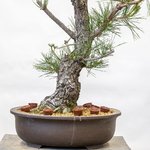Kudo
Sapling
I currently have a couple of black pines which are still in initial trunk fattening and development phase. However, I’ve been studying a lot further pine techniques on more advanced material. On several sources they recommend developing trunk first and letting some low buds that will on the future be developed to became primary branches, just like this photo taken from Jonas Dupuich Bonsai Tonight blog:

Source: https://bonsaitonight.com/2019/05/2...ent-to-branch-refinement-japanese-black-pine/
We all know that low branches has to be bigger and more ramified than upper branches. So one question came to my mind: After developing trunk and starting to develop branches with buds that are almost the same size how will you avoid the upper branches becoming the same sizer or, worse, bigger and more ramified than lower branches?
As pines are apically dominant, the upper branches will grow more. We can balance the vigor by decandling but won’t this make upper and lower branches to be the same size and same number or ramifications?
I thought about not decandling lower branches and decandling upper branches to give more vigor and thicken lower branches, but this would lead to a more ramified upper branch than the lower branch. Is the answer decandling upper branches but only select one bud instead of two and letting lower branches grow untouched? What about intermediate levels of branches?
Thank you.

Source: https://bonsaitonight.com/2019/05/2...ent-to-branch-refinement-japanese-black-pine/
We all know that low branches has to be bigger and more ramified than upper branches. So one question came to my mind: After developing trunk and starting to develop branches with buds that are almost the same size how will you avoid the upper branches becoming the same sizer or, worse, bigger and more ramified than lower branches?
As pines are apically dominant, the upper branches will grow more. We can balance the vigor by decandling but won’t this make upper and lower branches to be the same size and same number or ramifications?
I thought about not decandling lower branches and decandling upper branches to give more vigor and thicken lower branches, but this would lead to a more ramified upper branch than the lower branch. Is the answer decandling upper branches but only select one bud instead of two and letting lower branches grow untouched? What about intermediate levels of branches?
Thank you.
